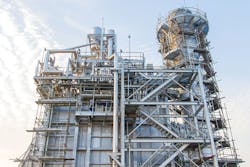In the power industry, every minute is critical. A smooth power plant startup is vital to operations and directly linked to layup procedures. A thorough understanding of critical layup and startup strategies and procedures, paired with a proper corrosion-control protection program, can prevent unscheduled downtime, reduce operating costs and increase reliability of power plant water equipment.
In the gas-fired combined cycle market, whether it is a baseload facility or a facility that regularly cycles, asset preservation is at the top of the list of objectives. It is important in the operational mode but critical in a standby or shutdown situation, because a delay of just 20 minutes can result in tens of thousands of dollars of lost revenue depending on the size of the operation and power prices. How the power plant protects its water equipment during idle times has a direct effect on startup time, plant efficiency and unscheduled downtime.
The root cause of many common failures that typically occur during operation can often be traced to ineffective layup procedures. These include condenser leaks, turbine deposits, boiler tube failures caused by corrosion fatigue or hydrogen transport, and feedwater heater corrosion product transport. A well-documented strategy can help operations run smoothly.
The specific layup strategy will align with the duration of time the plant will be idle, how much time is available for shutdown, how quickly the plant needs to be operational, and the expected speed to operation. Although layup strategies will differ from plant to plant depending on varying shutdown and startup factors, corrosion protection is paramount whether the idle time is merely hours or as long as several months. The power plant water treatment equipment — inclusive of zero liquid discharge systems, open- and closed-loop cooling systems, and evaporative air coolers — must be protected to minimize startup time.
The power plant water treatment equipment — inclusive of zero liquid discharge systems, open- and closed-loop cooling systems, and evaporative air coolers — must be protected to minimize startup time.
Power plant idle times usually fall into one of the following categories based on the power purchasing agreement (PPA): hourly, daily, weekly or beyond weekly. For hot layup where need is typically hourly to daily, slight pressure and proper cycle chemistry should be maintained. A vacuum should be present on the condenser to ensure the proper steam seal is maintained. For wet layup where there is typically a daily to weekly need, drum levels and turbine vacuum should be maintained while ensuring a nitrogen or steam blanket is sustained. With all wet chemistry, regular testing procedures should apply. For long-term layup, the heat recovery steam generators (HRSGs) should be drained “hot,” meaning the hot well should be drained dry, and the turbine should be maintained at a specific relative humidity, because many turbine issues are caused by improper layup. Sample panels and analyzers should also be protected.
To protect power plant water treatment equipment from corrosion, recirculate from filter effluent to clarifier influent to keep the system moving and the pumps active. The flow will be determined by system volume; typically, around 20 to 50 percent should be recirculated. Shut down and clean day tanks, and determine proper blowdown for the clarifier. Back-wash filters and leave them full of water with bleach for longer-term shutdown. Remove cartridge filters and clean out housings. Reverse osmosis (RO) units should be run every day with biocide to control biofouling. For seasonal operation, remove and bag membranes in 1 percent bisulfite solution. Clean out chemical tanks and pumps. Mixed-bed systems can be idle for a few days without running but should be ran in conjunction with the RO unit to keep water fresh for shorter terms. For seasonal shutdown, they should be regenerated at end of season, and cation/anion beads should be separated in mixed beds. Mixed beds should be aired prior to startup.
To protect power plant water treatment equipment from corrosion, recirculate from filter effluent to clarifier influent to keep the system moving and the pumps active.
In cooling towers, it is important to add biocide daily and monitor results in the open loop. While the scale and corrosion inhibitor can be reduced, corrosion must continue to be monitored during idle time. For longer-term outages, drain and clean the cooling tower basin while inspecting spray nozzles and repairing or replacing as needed. Open water boxes need to be inspected and cleaned. Clean the condenser tubes; check sacrificial anodes and replace if necessary. For the evaporative air coolers, drain and clean out the drain sump while inspecting the media for fouling slump, shifting or any damage. If damage is significant, the media should be replaced.
Regarding chemical storage during layup, bleach will continue to be fed to systems in most cases, but day tanks that are used for other applications should be cleaned out for long-term storage. Bleach should be purchased in smaller quantities and kept out of the sun because time, temperature and ultraviolet rays can cause bleach to decrease in activity. Ensure that the vent and vent dryer on the acid tanks are operable to keep moisture out. The caustic tank heaters should be checked, and nitrogen blankets should be considered to keep CO2 out because moisture can reduce the activity of the caustic. Chemical pumps from other products that will not be fed should be removed and cleaned or rebuilt as necessary.
Vapor phase Corrosion Inhibitors (VpCI) are effective for corrosion control. VpCIs work in the vapor phase rather than the contact phase or interphase, so they are able to protect the metal as a single layer of corrosion protection wherever air can get into the system. These chemistries can be removed during the plant’s first cycle with no adverse effects, so there is no additional step of removing the chemicals before startup. This allows startup to begin sooner without any time wasted and can protect for as long as the system will be down.
VpCIs are environment, health and safety (EHS) preferred due to their low toxicity, which make them easy to ship, apply, store, handle, use, leave in, remove and dispose of. Certain applications of VpCIs are simple enough to be performed by on-site staff, while applications with more complicated geometries or specific dosage amounts should be performed by a qualified professional.
For turbines, pumps and compressors, VpCIs can be used in the flow path, lubrication systems, foundation, external surfaces and fasteners. In boilers, HRSG units and steam lines with complex geometries, VpCIs can protect the tube internals, shell fire box and smoke stack, and they can be injected in wet or fire sides of the unit. VpCIs can protect junction boxes and control panels that can corrode easily during shutdown. They can also provide protection for operational and critical spares for equipment that is not currently in use. A common solution for these items is a type of VpCI plastic that can be wrapped around the equipment for up to two years and requires no cleaning of the spare parts before reuse.
Conclusion
Every moment is critical in the power industry, and startup success relies upon effective layup procedures. Make sure to have the right expertise for proper layup and startup, and take the time for necessary modifications of power plant water treatment equipment to avoid lost revenue.
Joe Tirreno, VP of Strategic Sales for U.S. Water, has more than 30 years of experience in power plant water systems, system design and water plant operations. U.S. Water provides integrated water management for industry, combining chemical, equipment, engineering and service for customized solutions to reduce water and energy usage and improve efficiency.




